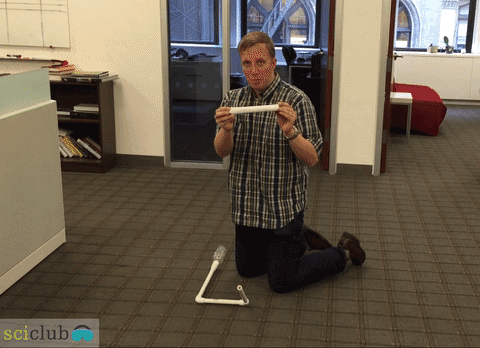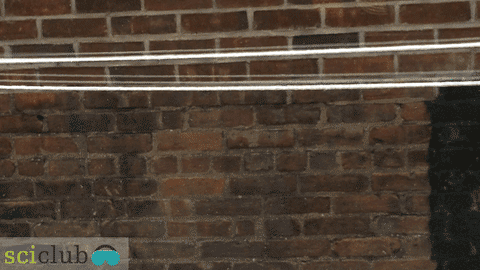We want you to invent a new mode of communication.
- Invent a device or system that can send or carry a message from one place to another.
- Share your communication contraption with the hashtag #MessageChallenge.
- Check back here through the end of November to see everyone’s submissions.
We want you to invent a new communication device or system—that is, a contraption that can send or carry a message over some distance, whether it’s across the room, across the street, or across the park. Then, we want you to demonstrate that your device works. Feel free to use, hack, or otherwise repurpose existing technology—just don’t use it in the way it was originally intended. In other words, chatting over a pair of walkie-talkies or using your cell phone to text your friend don’t count.
Check Out The Submissions!
For a full gallery of submissions for the #MessageChallenge, visit our submission gallery!
The Science Club Tackles a Communications Challenge
How to Share Your Invention
You can submit your photo, video, or audio demonstration of your device in one of the following ways:
- Twitter – Tweet a picture or video @SciFri with #MessageChallenge
- Instagram – Instagram a picture or video using #MessageChallenge
- Tumblr – Post a picture to SciFri’s Tumblr (click the check mark for #MessageChallenge)
- YouTube – Upload a video of your project using #MessageChallenge
- Vine – Post a Vine of your project using #MessageChallenge
- Pinterest – Post a picture of your project using #MessageChallenge
- Write us – Share your plans in the comments section below or send them to scienceclub@sciencefriday.com
- Voice recording – Record a voice memo and send it to scienceclub@sciencefriday.com. For helpful instructions for sending a voice memo using a smartphone, click here.

Science Club FAQ's
What is Science Club?
SciFri’s Science Club challenges you to go out, do science, and share it with others.
Twice a year we’ll challenge you to try something new during the live Science Friday radio broadcast. Sometimes you’ll make or build something. Other times you’ll investigate a question that experts might not even know how to answer. Using e-mail or social media, share your discoveries with other participants over the following weeks, then tune in to Science Friday to hear our panel of experts highlight the most interesting, significant, and unique findings or creations. Science Club is open to any interested person, lab, institution, club, school, student, educator, or organization. As we see and receive new project posts, we’ll feature them here on the site and in our Rebelmouse gallery. For more information about Science Club and to see past examples, click here.
I’m a parent/scientist/artist/student/cat herder/etc. Can I participate?
Short answer: YES!
Everyone is invited, no matter where you are, what you do, or how little experience you have inventing things. Think about the materials that you have around you to work with. If all you have are paper clips and some rubber bands, you can still participate in this science club. Keep checking this page for more ideas and to see what others have submitted throughout the month.
What kinds of devices can I make?
Short answer: Anything of your own design that can send or carry a message across some distance.
You could make a device that uses light to send messages across a park, or uses smells to communicate your feelings. All media are allowed, whether your device uses mechanical, acoustic, electronic, visual, or even olfactory means to send a message. The only thing that is off-limits is using a pre-existing communication device for its original function. In other words, sending a text message from one smartphone to another just won’t cut it.
How can I show you that my communication device works?
Short answer: Anyway you want to!
You could capture a video of your device in action, take photos of it, tweet photos of your design to us @scifri, or record yourself explaining your design. There are many, MANY ways to share your invention, check the list of ways to share your invention at the top of this page. Just make sure it’s something you’re proud of!
I’m a teacher. Can I do this as a class project?
Short answer: Yes!
Students are amazing innovators; we would love your help sharing their ingenuity and creativity in solving engineering challenges like this one. You may send us photos, excerpts from class projects, dance performances, observations, lab data, figures from lab reports, or really any other classroom artifact. If you plan to submit anything that includes the face or voice of a student under age 18, however, make sure that you’ve received permission from a parent or guardian (e.g. a general media, photo, or press waiver). If you prefer that students submit their own media, please guide them in best practices of Internet safety and privacy—for instance, instruct them to avoid including identifying personal information or images in their submissions. We assume that as a participating educator, you and your class are adhering to your school or district’s Internet use policy.
How can I submit an audio explanation?
Record a voice memo explaining your device and how it works and e-mail it to us at scienceclub@sciencefriday.com. We might play your submission during our live show on November 20th, 2015! For tips on how to record a voice memo, check out the animation below or read more here, and see the helpful gif below:
Meet the Writer
About Ariel Zych
@arieloquentAriel Zych is Science Friday’s director of audience. She is a former teacher and scientist who spends her free time making food, watching arthropods, and being outside.
